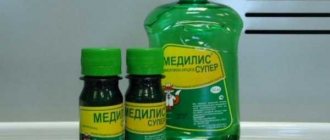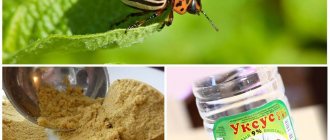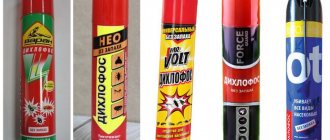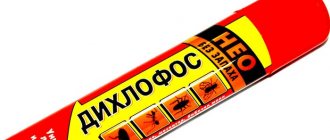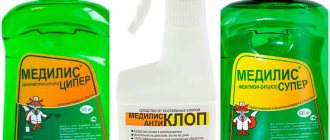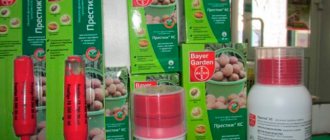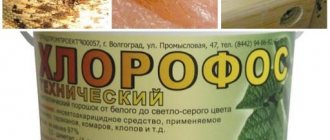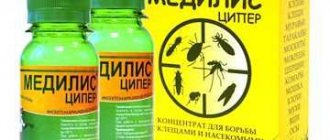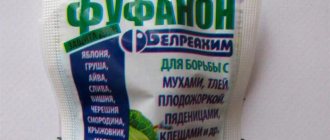For many centuries, cockroaches have coexisted with people, constantly trying to penetrate their homes and causing many problems and inconveniences with their presence. That is why the issue of getting rid of these insects is still very relevant today.
Unfortunately, cockroaches have very successfully learned to adapt to all kinds of insecticides. This makes their complete eradication from residential premises a very difficult process. At the moment, there are several effective methods of pest control, but one of the most popular and successful over the years has been and remains the use of Dichlorvos. It is this miracle remedy that will be discussed in our article.
Composition and properties
Many people remember Dichlorvos as it was in Soviet times, but this version has long ceased to be produced. The fact is that the drug contained dimethyldichlorovinyl phosphate, which effectively destroyed colonies of parasites, even the largest of them. The chemical compound had a negative effect not only on pests, but also on humans: it caused serious poisoning and a general deterioration in health. Therefore, the chemical was forced out of the market.
With the development of technology, manufacturers have been able to create the safest drugs that fight insects well without having a negative effect on humans.
Currently, the composition of Dichlorvos has changed greatly. Each manufacturer makes a unique set of components, but all such insecticides contain the following chemicals:
- cypermethrin;
- tetramethrin;
- permethrin;
- piperonyl butoxide.
Cypermethrin is a popular insecticide of contact action, that is, to obtain an effect it must get onto the chitinous cover and into the respiratory tract.
The active formula blocks the nervous system of cockroaches, bedbugs, ants, flies, fleas, disrupting the transmission of nerve impulses and thus paralyzing the pests. Unable to move, search for food, or breathe, the parasites die.
Also, third-party components that do not affect the effectiveness are added to the drug:
- fragrances;
- ethanol;
- preservatives;
- stabilizers.
Dichlorvos acts for a week and then disappears. It is necessary to carry out repeated treatment if the population is large. But the effect is noticeable almost immediately: already on the second day after spraying.
The chemical is available in the form of sprays with a volume of 10 to 30 ml, in canisters up to 10 liters. The convenient shape allows you to kill insects yourself.
There is no exact answer to the question of whether Dichlorvos is harmful to humans. If used correctly and if you are not allergic to the components, the chemical will be safe.
However, if you violate the rules of use, you can become poisoned with Dichlorvos and get unpleasant symptoms.
Security measures
In Soviet times, the question of whether Dichlorvos is harmful to humans was not on the agenda. Everyone understood that it was really harmful. Nowadays, thanks to the changed formula, it is not so dangerous to health, but nevertheless it is necessary to remember that Dichlorvos is a rather aggressive drug, so it should not be allowed to get into the mouth, nose, or eyes.
The drug is also dangerous when it gets on hygiene items. Therefore, soap, personal belongings, and food must be removed before treatment with Dichlorvos.
In addition, you must wear protective equipment:
- clothes with long sleeves;
- scarf or hat;
- gloves:
- glasses.
Means of protection
People and animals are also first removed from the house. A few hours after treatment, the premises are ventilated and wet cleaning is carried out.
Instructions for use
When treating premises and clothing against bedbugs, cockroaches, fleas, and moths, several precautions should be taken:
- clear the apartment of small children and pets. It is recommended to remove indoor plants, as modern products can still harm them;
- Use protection: respiratory mask, thick long rubber gloves, safety glasses. Take clothes that are as closed as possible;
- Do not spray Dichlorvos near food, it is advisable not to use it in the kitchen or at least remove all food from the room for several days until the effect of the product wears off;
- If the chemical comes into contact with your skin, wash it immediately with clean water and soap;
- do not treat the surface near open fire;
- If the chemical gets into your eyes, rinse them immediately with plenty of water and consult a doctor;
- If symptoms of poisoning appear (dizziness, nausea, blurred vision, etc.), you need to call an ambulance.
Before exterminating bedbugs and cockroaches, an apartment or premises should be carefully prepared for treatment:
- wipe furniture and floors with a damp cloth to remove dust and dirt;
- free all corners and hard-to-reach places to process them;
- block all escape routes for cockroaches and bedbugs: close windows, doors, seal all cracks, install fine mesh for ventilation;
- remove the mattress. It should not be processed, since even after the smell has evaporated, the product will remain inside the filler, negatively affecting health.
Dichlorvos must be used as shown in the instructions on the package. The sequence of actions for all brands is approximately the same:
- Close all windows and doors in the room.
- Shake the can well.
- Spray the spray, keeping it at a distance of about 20 cm from the surface. If you bring the can closer, the spray will be uneven; if you move it away, the effect will worsen.
- After complete treatment (corners, baseboards, floors, ventilation grilles, cabinets, door jambs), leave the room for 3-4 hours.
- When the smell dissipates a little, wipe all surfaces with a damp cloth - this will remove the “aroma” of the poison.
- Mix 50 g of grated laundry soap, 50 g of baking soda, 5 liters of water.
- Wipe the surfaces that the apartment residents come into contact with with a cloth soaked in the resulting solution.
- After 3-4 weeks, carry out general cleaning: treat floors, shelves, furniture, cracks, hard-to-reach places with detergent or whitening solution (20 ml per 10 liters of water).
Attention! The aerosol only affects larvae and adults; it will not help get rid of eggs. Therefore, after the first treatment, it is necessary to re-spray the product in the room after 2-3 weeks. It is not advisable to carry out general cleaning during this time period; the chemical should remain in hard-to-reach places: in cracks, corners, under baseboards, on ventilation grilles.
Not only apartments, furniture, but also textiles are treated with dichlorvos. This should be done as a last resort if boiling, ironing, freezing, or steaming did not help. The spray kills parasites, but may cause irritation if it comes into contact with the skin.
To destroy insect larvae found on clothing and bedding, follow the instructions:
- Place textiles in a sealed bag.
- Spray Dichlorvos inside; it is better to choose an odorless product.
- Close the package.
- Leave for 3-4 hours.
- After treatment, wash bed linen and clothes at the maximum permissible temperature, boil if possible.
- Iron things.
Attention! Under no circumstances should Dichlorvos be used to treat underwear or clothing that frequently comes into contact with the skin: T-shirts, tank tops, trousers, jeans. It is forbidden to splash children's things with chemicals. After treatment, items should be washed several times.
Fleas
Dichlorvos can only be used to remove fleas when treating pet bedding, carpets, and furniture, but it should not be applied to the pets themselves.
Flea
It is necessary to spray the aerosol on the walls to a height of up to 1 m (the height of an insect's jump). After 10-12 days, the treated items must be washed in the hottest possible water, and the walls and furniture must be thoroughly washed with detergents.
Insect control
Dichlorvos is a universal drug that acts on different types of insects. But for each you need to choose your own approach: this is how the treatment of the room will be most effective.
Bedbugs
Bedbugs are blood-sucking parasites; the poison cannot enter their body with food. Dichlorvos will work if you spray all surfaces with which uninvited guests come into contact. It is also necessary to find nests - this will help destroy most of the uninvited guests. Typically, bedbugs live in sofas, beds, armchairs and other upholstered furniture, mattresses, bed linen, old furniture, and books.
To get rid of bedbugs using Dichlorvos, you need to:
- Free up hard-to-reach places.
- Find nests.
- Spray them at a distance of about 25 cm.
- Repeat treatment after 7-14 days.
The chemical is also effective in the fight against bed bugs. To withdraw them, follow these instructions:
- Remove bed linen.
- Wash it at high temperatures, treat it with an insecticide, wash it again.
- Remove the mattress.
- Find a nest of bed bugs.
- Spray it with spray.
- Treat the sleeping area.
- Leave for 3-4 hours.
- Ventilate the room.
- Wipe furniture and floors with a damp cloth soaked in a solution of 0.5 pieces of laundry soap and 1 liter of water.
- After 1.5 -2 weeks, re-treat.
Advice! During the treatment period, it is better to sleep in a different place.
Before poisoning bedbugs, warn your neighbors about this if you live in an apartment building. Uninvited guests may run to nearby apartments to escape the poison. It is best if neighbors begin to remove parasites at the same time and take preventive measures.
Cockroaches, ants
The effect of Dichlorvos on cockroaches is not so effective; it is best to combine the aerosol with other means, for example, traps.
Insects die when they come into contact with the insecticide. It is necessary to treat all surfaces where they have been. Most often, cockroaches live in the kitchen, in which case you need to act very carefully: you must not allow the poison to get into your food or dishes. Use an odorless chemical to prevent it from becoming embedded in your kitchen furniture.
Dichlorvos against cockroaches will help if you follow the instructions:
- Deprive pests of access to water - cockroaches will not live long without liquid.
- Remove all dishes, or at least cover them with plastic wrap.
- Remove food from the kitchen.
- Clear all hard-to-reach places.
- Spray all cracks, baseboards, corners, cabinets, shelves.
- Treat floors and walls.
- Close the room, leave it.
- After 1.5-2 hours, ventilate the kitchen.
- Carry out wet cleaning with a solution of 0.5 bars of laundry soap and 1 liter of water.
- Repeat the procedure for removing cockroaches after 2-3 weeks.
The principle of operation of Dichlorvos against ants is similar: you need to spray the aerosol in the room where insects were seen most often.
However, there are some nuances here:
- To effectively get rid of an ant colony, you need to find the nest where the queen lives. There may be several such places. The chemical is sprayed over the nest at a distance of 20-30 cm;
- Foraging ants usually remember the path from the nest to the food source and always use it. By observing the habits of insects, you can find their habitat.
Attention! As with bedbugs, warn your neighbors before poisoning cockroaches and ants. These insects can also move into neighboring apartments.
Fleas
Dichlorvos against fleas helps when all their habitats have been thoroughly treated. Pests usually hide in pet bedding, on carpets, rugs, and behind baseboards. To get rid of fleas, you need to spray the product on these objects, walls, furniture up to 1 m high. These pests can jump high, so if you miss a section of the wall or habitat, the fleas will return very soon.
Do not spray the chemical near food bowls. Bedding and blankets must be washed well at high temperature 1-2 weeks after flea removal. Before washing, pets should not be allowed on them; people should also limit contact with treated items.
Attention! To completely destroy fleas, you need not only to treat the surfaces, but also to remove pests from the animal’s fur. Use special drops, a collar, and shampoo.
Flies, mosquitoes, wasps
Dichlorvos helps against the invasion of wasps, mosquitoes, flies, and midges in the apartment. To get rid of flying individuals, follow these recommendations:
- Apply the product to the areas where most pests are usually found.
- Spray the product around the apartment.
- Leave for 3-4 hours, during which time residents should not be at home.
- Ventilate all rooms.
- After 30-60 minutes, carry out wet cleaning.
Repeat this procedure after 6-7 days to ensure that flies, midges and wasps are removed.
Attention! To get rid of mosquitoes, it is more convenient to use safer means, for example, fumigators. They act just as effectively, but cause much less harm to health.
Mole
To get rid of moths using Dichlorvos, you need to:
- Remove all clothes and shoes from the closet.
- Take fur and fur coats out onto the balcony or street.
- Spray the chemical inside.
- Leave the cabinet closed for 2-3 hours.
- Spray a large fabric or clothing cover with the aerosol.
- Cover fur items with this material so that they absorb the smell.
- Open the cabinet doors and leave the windows in the room open to ventilate the furniture a little.
- Wipe the shelves with cleaning liquid.
- Repeat treatment after 3-4 weeks.
In addition, the product is used as a prophylaxis. Before storing wool or fur, wrap it in paper sprayed with poison.
The insecticide is allowed to be used only for clothes and textile moths. It is highly undesirable to use it on kitchen cabinets and shelves, as the product remaining on them will poison food. Floors and baseboards can be sprayed, but before doing this, you must remove all food from the room and use the room less often for 2 weeks after spraying.
Attention! To protect your cabinets from moths, place bags of dried lavender and dried citrus slices on the shelves.
Lice
Dichlorvos also helps get rid of body lice. It effectively kills adults, but is completely harmless to nits - parasite eggs have a special protective shell, so the treatment must be repeated 2-3 times every 2-3 weeks.
You can remove body lice with Dichlorvos as follows:
- Place contaminated items in large plastic bags.
- Spray an aerosol inside them.
- Leave for 1-2 hours.
- Wash on high temperature.
- Iron at the maximum permissible setting.
It will not be possible to remove lice on the head with Dichlorvos, since the chemical is very toxic, causes skin irritation, peeling, and often leads to hair loss. There are more convenient and safer remedies for head lice.
Other insects
The insecticide also helps get rid of other annoying insects, both in the house and in the garden.
For example, Dichlorvos is used to remove spider mites from indoor plants. Instructions for use are as follows:
- Cover the plant with a cardboard cone or plastic bag.
- Make a small hole in it.
- Spray the flower with insecticide.
- Leave for 5-7 minutes.
- Remove the cap and bag.
- Repeat treatment after 6-8 days.
Attention! If possible, use another product, as the drug is harmful to plants and soil.
Dichlorvos will help remove spiders and double-wort, but the former are not so susceptible to the chemical. Follow this procedure:
- Spray the poison in all hard-to-reach places, especially damp and warm ones.
- Treat areas where traces of two-wort or cobwebs were noticed.
- Leave the apartment for 2-4 hours.
- Ventilate the rooms.
- Wipe floors and walls with a damp cloth.
Another way to use Dichlorvos is to kill aphids on roses. It is necessary to treat flowers according to the instructions, just like indoor plants when spider mites appear. In this case, there is no need to cover the plant with a cone, because the processing takes place in the fresh air.
Again, the chemical is quite aggressive, it is better to use less toxic products.
Ants from the garden are also removed with Dichlorvos. To do this, spray the product over the anthill and around it.
Bedbugs
Instructions for using Dichlorvos to kill bedbugs have their own characteristics. The aerosol must be used to treat those places with which they come into contact, and these are upholstered furniture, bedding, beds, books, peeling wallpaper, electrical sockets and switches.
To find bedbug nests, you need to move cabinets, dismantle beds, and take out books. Having discovered a nest, it should also be treated with an aerosol, spraying Dichlorvos and around it at a distance of about 25 cm. Repeated treatment is carried out after a week.
Popular brands
The effectiveness of an insecticide largely depends on its manufacturer. There are several popular companies that have proven themselves.
"Neo"
The advantage of the Neo brand is that it is odorless Dichlorvos. There are also flavored options, with the smell of lemon and mint.
Dichlorvos "Neo", despite its relative safety, is a potent chemical. It contains permethrin, cypermethrin and piperonyl butoxide, which effectively destroy crawling and flying pests.
Due to its gentle action, the insecticide is used to treat livestock from psoroptosis, scabies, otodectosis, and pediculosis. But it is not recommended to treat pets - cats, dogs, rabbits - with the chemical, since their skin is more delicate. In addition, a pet can become poisoned by licking poison from its fur.
The validity period of “Neo” is 14 days, and during this time the aerosol retains its qualities. The spray is available in a 190 ml bottle, which is enough to treat a room of less than 40 m².
"Varan"
Unlike "Neo", "Varan" contains piperonyl butoxide. But, despite one more component, this drug is less effective, since the concentration of substances in it is much lower.
The effect of the insecticide lasts for 3 weeks; after this period, the treatment will need to be repeated.
It mainly fights cockroaches, bedbugs, and ants.
"Eco"
The main advantage of “Eco” is the smell - a light aroma of lavender. Another plus is the large volume of the cylinder – 250 ml, which allows you to treat several rooms at once.
Dichlorvos helps get rid of flies, midges, moths, as well as cockroaches, bedbugs, and ants.
Quite effective, but wears off quickly.
"Universal"
The composition includes several active ingredients: cypermethrin, permethrin, tetramethrin, piperonyl butoxide. Due to this, “Universal” is suitable for combating all types of insects. It acts quickly and helps destroy even large colonies.
"Terminator station wagon"
Like “Universal”, it is suitable for killing all types of insects, it works even in the open air, and copes well with large colonies.
However, the smell of “Terminator” is very strong, pungent, and the composition contains toxic impurities. Therefore, you should not use this brand of insecticide if there are children in the house.
The big disadvantage of this product is the pungent odor that does not dissipate from the apartment for a long time. Moreover, some things can absorb the “aroma”; it cannot be removed.
"Extra"
Dichlorvos of this brand destroys uninvited guests very well, even if their population has grown greatly. At the same time, “Extra” has a very pungent odor; it is not recommended to use it in a closed room. Leave a window or door slightly open to allow fresh air to flow in.
"Clean house"
The product under this brand is valid for 3 weeks. It effectively fights adults and larvae.
However, the substances contained in the “Clean House” lose their properties under the influence of ultraviolet radiation. Therefore, the insecticide should not be left in direct sunlight.
Varieties
An ideal remedy for cockroaches should combine two main characteristics: mercilessness towards insects and a low level of toxicity for humans and animals. From the wide range of products presented in hardware stores, several of the most popular can be identified. These are analogues of Dichlorvos, which are sold under other or combined names. Their characteristics are given in the table.
Table - Characteristics of popular cockroach repellents similar to Dichlorvos
| Name | Active components | Peculiarities | Price, rubles (data as of January 2022) |
| "Varan" | — Tetramethrin; - cypermethrin; -dimethyldichlorovinylphosphate | — Activity for 12 days; - the smell of lemon; — required exposure time — 7 hours | 100 |
| "Clean house" | — Tetramethrin; - cyphenothrin | — Designed to process 20 square meters. m.; - without smell; — required exposure time — 48 hours; - repeated events - in a week | 200 |
| "Neo" | — Permethrin; - cypermethrin; — piperonyl butoxide | — Activity for 5 days; - odorless, lemon scent, mint scent; — required exposure time — 15 minutes; — designed to process 15 sq. m.; - low probability of resistance | 150 |
| "Raid" | - Cypermethrin; - prallethrin; - imiprotrine | — Activity for 15 days; — contact impact; — designed to process 20 sq. m.; - forms an oily film on the surface | 250 |
Advantages and disadvantages
Dichlorvos has both advantages and disadvantages.
Among the advantages are:
- fast, complex impact;
- Ease of use;
- relative safety for humans;
- the presence of biodegradable components that do not generate toxic waste after use;
- versatility;
- duration of action.
The drug has the following disadvantages:
- the need to process the room several times to achieve results;
- the likelihood of allergic reactions: itching, redness of the skin;
- acrid odor;
- remains on surfaces for a long time, which is especially bad if there is a small child or pets in the house;
- harm to humans after prolonged contact with the drug.
Recommendations
- ^ a b
"Dichlorvos".
Haz card
. US National Library of Medicine. August 2015. Retrieved 2015-10-13. - Das S (2013). "Review of the toxicity of dichlorvos to fish." Current World Environment Journal
.
8
(1). Doi:10.12944/CWE.8.1.08. - “Which pesticides are banned in Europe?” (PDF). pan-europe.info
. 2008. - Gillett JW, Harr JR, Lindstrom FT, Mount DA, St Clair AD, Weber LJ (1972). "Evaluating the Human Health Hazards of Dichlorvos (DDVP), Particularly in Resin Strips." Remnant Reviews
.
44
: 115–59. Doi:10.1007/978-1-4615-8491-9_6. ISBN 978-0-387-05863-4. PMID 4576326. - Pancetti F, Olmos S, Dagnino-Zubiabre A, Rosas S, Morales B (December 2007). "Noncholinesterase effects induced by organophosphorus pesticides and their relationship with cognitive processes: implications for acylpeptide hydrolase action." Journal of Toxicology and Environmental Health, Part
B.
10
(8): 623–30. CiteSeerX 10.1.1.334.9406. Doi:10.1080/10937400701436445. PMID 18049927. - Booth ED, Jones E, Elliott BM. (December 2007). "Review of the genotoxicity of dichlorvos in vitro and in vivo". Regulatory toxicology and pharmacology
.
49
(3): 316–26. doi:10.1016/j.yrtph.2007.08.011. PMID 17936460. - Espeland, M., Irestedt, M., Johansson, K. A., Akerlund, M., Berg, J. E., Kellersjö, M. (January 2010). "Exposure to dichlorvos interferes with the extraction and amplification of insect DNA in museum collections." Frontiers of Zoology
.
7
: 2. Doi:10.1186/1742-9994-7-2. PMC 2819063. PMID 20148102. - Mennear JH (June 1998). "Dichlorvos: a regulatory puzzle." Regulatory toxicology and pharmacology
.
27
(3): 265–72. Doi:10.1006/RTph.1998.1217. PMID 9693077. - "Dichlorvos (DDVP): exclusion of certain applications and directions." US Environmental Protection Agency: Office of Pesticide Programs. April 19, 1995 pp. 19580–19581. Paper control number OPP-38511.
- Vina M (September 11, 2014). “Pesticide levels in waterways have dropped, reducing risks to people.” New York Times
. - Brooks M. (May 17, 2010). "Organophosphate Pesticides Associated with ADHD." Medscape
. - Bouchard MF, Bellinger DC, Wright RO, Weiskopf MG. (June 2010). "Attention-Deficit/Hyperactivity Disorder and Urinary Organophosphate Pesticide Metabolites" (PDF). Pediatrics
.
125
(6):e1270-7. Doi:10.1542/pedy.2009-3058. PMC 3706632. PMID 20478945. - Raeburn, P. (August 14, 2006). "Slow acting." Scientific American
. Vol. 295 no. 2. paragraph 26. doi:10.1038/scientificamerican0806-26. - ^ a b
NIOSH Pocket Guide to Chemical Hazards. "#0202". National Institute of Occupational Safety and Health (NIOSH). - “The preferential effect of Dichlorvos (Vapona) on bacteria deficient in DNA polymerase” (PDF). Cancer Research
. - "A Grand Court Victory for Public Health." www.nrdc.org
. - ^ a b
"Dichlorvos".
Immediately hazardous to life and health (IDLH) concentrations
. National Institute of Occupational Safety and Health (NIOSH). - Brunner, John (1972). Sheep look up
. New York: Ballantine Books. p. 220. ISBN 978-0-06-010558-7. LCCN 72-79705.
Dichlorvos poisoning
Despite the fact that the modern version of the drug does not contain highly toxic, poisonous substances, you can still be poisoned by Dichlorvos. In addition, allergies often occur after its use.
There are several reasons for the appearance of negative reactions in the body:
- penetration of the chemical into the respiratory tract and mucous membranes;
- entry into the digestive tract.
In case of Dichlorvos poisoning, you must immediately call a doctor and provide first aid.
Symptoms
There are several signs of Dichlorvos poisoning:
- dizziness;
- nausea;
- vomit;
- diarrhea;
- intoxication;
- skin itching;
- cough;
- sudden change in pressure;
- lack of coordination;
- temperature increase;
- headache;
- swelling of the eyelids, conjunctivitis if it gets into the eyes;
- cramps, spasms;
- loss of consciousness.
Typically, symptoms of Dichlorvos intoxication disappear after 2-3 days. But if a person suffering from allergies inhales the chemical, complications may begin.
Treatment
After the ambulance is called, you need to provide first aid to the poisoned person.
In case of intoxication, you must do the following:
- Get out into the fresh air.
- Rinse the damaged areas with cold clean water if the drug comes into contact with the skin, mucous membranes, or eyes.
- Remove clothing and protective elements in which the room was treated.
- Induce vomiting.
- Drink plenty of fluids.
- Take 10 tablets of activated carbon.
- Take an allergy medicine if you have reactions to any of the ingredients.
Chemical basis
Successors of the “real” DDVF for household use are created on the basis of pyrethroids - insecticidal agents first isolated from the plant Tanacetum (Pyrethrum) parthenium (tansy (pyrethrum maiden) or Dalmatian chamomile), see Fig. on right. Its insecticidal properties have been known since ancient times; In addition, pyrethrum is the ancestor of many varieties of garden “Persian” daisies.
Note: why - girlish? In ancient times, an aqueous extract of pyrethrum was used to terminate an unwanted pregnancy. But don’t skimp on abortions in this way if you really can’t give birth. Ingestion of pyrethrum infusion causes severe poisoning, after which incurable disorders of women's and general health are very likely. The “knocked-out” girls of antiquity had nowhere to go - in those days, in many countries, a girl of marriageable age who did not preserve her virginity before marriage faced a slow, painful death penalty. But a husband can forgive or reconcile if he is not the reason for it; Pyrethrum was introduced into use by nuns - a nun who gave birth was supposed to be walled up in the wall of the monastery alive along with the baby.
Advantages
Organophosphorus compounds appeared on the insecticide market several decades ago. They are gradually being replaced by new drugs with an improved formula, high efficiency, but less toxicity. But people cannot yet completely abandon the use of this group of insecticides: solutions and aerosols quickly and efficiently destroy parasites and pests of almost all categories.
Pros:
- the universal composition has a detrimental effect on many flying and crawling insects;
- the drug is effective for destroying secretly living pests;
- high insecticidal activity has been confirmed by professional exterminators and millions of owners who have used the product to combat cockroaches, ticks, flies, moths, bedbugs, and fleas;
- the complex effect ensures 100% disinfestation results;
- the presence of three active ingredients reduces the likelihood of resistance: Dichlorvos acts even on pests and parasites that have adapted to the influence of weaker insecticides;
- prolonged action - active components are effective for two weeks after treatment;
- minimal aerosol consumption guarantees high performance;
- after treatment, the drug residues quickly decompose into compounds that are safe for people and pets;
- low price. Dichlorvos Neo belongs to the insecticides of the low price segment. The combination with a small consumption of the drug for treating a medium-sized apartment ensures the minimum cost of disinfestation at home.
Treatment in hospital
The need for hospitalization is determined by the emergency doctor or hospital where the victim went. If there is such a need, the patient will be prescribed such treatment methods.
- Gastric lavage using a tube.
- In case of seizures, medications for them.
- Antidote – atropine sulfate or alox.
- Medicines for the heart, since it is under excessive stress from the poison.
- Antibacterial agents to prevent secondary infection.
- If breathing is impaired - artificial ventilation.
Customer Reviews
Olga, 38 years old, Ryazan: “When bedbugs appeared in the apartment, I didn’t even know what to do about it. At first I tried to use folk remedies - wormwood. But the latter is not particularly effective, so I had to buy Neo aerosol. The last one is odorless. After the second treatment it helped, we got rid of the parasites.”
Alina, 40 years old, Ufa. “I also remember the old Soviet dichlorvos, from which even a respirator didn’t really help, but cockroaches and bedbugs disappeared. Modern means are more comfortable for a person in this sense, but at least 2 treatments have to be carried out. For the first time I used Combat, then I decided to change the product so as not to be addictive, and treated my home with Neo. The second drug is more effective. At the same time, it does not have an unpleasant odor.”
[vote2x id=”2624" align=”center”]
Consequences
Dichlorvos is characterized by the fact that its exposure causes both immediate consequences (complications) and long-term consequences.
Complications appear within two weeks from the moment the substance enters the human blood. The patient begins to suffer from:
- toxic hepatitis;
- nephropathy;
- pneumonia;
- dystrophy of the heart muscle.
Long-term consequences appear within three years from the moment the substance enters the human blood. The patient begins to suffer from:
- astheno-vegetative syndrome : disturbances in the functioning of internal organs due to poor functioning of the autonomic system;
- myeloradiculitis : simultaneous inflammation of the human spinal cord and spinal roots;
- polyneuritis : diseases of the peripheral nervous system.
For pregnant women, dichlorvos poisoning is doubly dangerous. If it occurs during an early period, the fetus may freeze. If during the last months, the fetus may develop developmental abnormalities or even the death of the unborn child.
How to use the product correctly
You can successfully poison cockroaches with these chemicals at home only if you follow all the instructions and rules for their use. In order to carry out disinfestation most effectively and avoid negative consequences, follow our advice:
- Remove all residents, including pets, from the apartment or private house.
- Remove bed linen and personal items. Pack food and dishes in plastic bags, roll up carpets and place them in a corner. If possible, move furnishings away from all walls and close windows tightly.
- Shake the can of the product very thoroughly and spray it at a distance of 15-20 cm from the surface in the favorite places where insects live, such as: cracks in the floors, holes under baseboards, wallpaper and furniture, around doors and window frames, behind pipes and radiators, in in and behind kitchen cabinets, near sinks and under pipes.
- After spraying is completed, immediately leave the living space for at least 3-4 hours - the longer you are gone, the more effective the destruction of insects will be.
- Upon returning home, be sure to thoroughly ventilate all the rooms (initially it may smell bad or stink, but this unpleasant aroma will disappear fairly quickly) and immediately do a general wet cleaning to prevent the risk of poisoning.
Despite the fact that “Dichlorvos” is effective against cockroaches already from the first treatment, it is advisable to repeat all the above manipulations with a break of 10 days. This way you will be able to achieve the greatest efficiency in pest control and will be sure that even single individuals did not survive.
Tip: a small part of cockroaches, after treating the premises with an insecticidal aerosol, as a rule, escape to neighbors through the ventilation openings. Therefore, to prevent them from returning after a couple of weeks, it makes sense to place traps in the indicated places, apply crayons or gels with a longer action.

